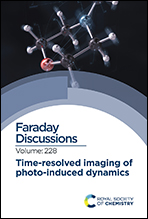Molecular fragmentation as a way to reveal early electron dynamics induced by attosecond pulses†
Abstract
We present a theoretical study of the electron and nuclear dynamics that would arise in an attosecond two-color XUV-pump/XUV-probe experiment in glycine. In this scheme, the broadband pump pulse suddenly ionizes the molecule and creates an electronic wave packet that subsequently evolves under the influence of the nuclear motion until it is finally probed by the second XUV pulse. To describe the different steps of such an experiment, we have combined a multi-reference static-exchange scattering method with a trajectory surface hopping approach. We show that by changing the central frequency of the pump pulse, i.e., by engineering the initial electronic wave packet with the pump pulse, one can drive the cation dynamics into a specific fragmentation pathway. Reminiscence of this early electron dynamics can be observed in specific fragmentation channels (not all of them) as a function of the pump–probe delay and in time-resolved photoelectron spectra at specific photoelectron energies. The optimum conditions to visualize the initial electronic coherence in photoelectron and photo-ion spectra depend very much on the characteristics of the pump pulse as well as on the electronic structure of the molecule under study.

- This article is part of the themed collection: Time resolved imaging of photo-induced dynamics


 Please wait while we load your content...
Please wait while we load your content...